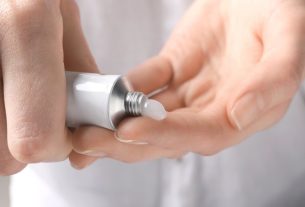Exemestane is a medicine indicated for the treatment of breast cancer in postmenopausal women, who have a positive estrogen receptor, as it works by blocking the production of this hormone, preventing the growth of the tumor that depends on estrogen to multiply.
This medicine can be purchased in pharmacies or drugstores in the form of 25 mg tablets, as the generic “exemestane” or under the trade name Aromasin.
Read too: Breast cancer: what it is, symptoms, causes and treatment
Furthermore, exemestane can be provided by the SUS or health plans, as long as there is a recommendation from an oncologist and a medical report proving the need for treatment.
What is it for
Exemestane is indicated for:
- Early breast cancerafter treatment with tamoxifen for 2 or 3 years, to prevent the tumor from returning or developing in the other breast;
- Advanced breast canceras the first treatment option or when the tumor evolved after treatment with anti-estrogen drugs or after several hormonal treatments;
This medicine is indicated for breast cancer in natural or induced postmenopausal women with a tumor that has an estrogen receptor.
The use of exemestane must be carried out with the advice of an oncologist, for the duration of treatment indicated by the doctor and with regular examinations to evaluate the response to treatment.
Make an appointment with an oncologist in the nearest region:
Taking care of your health has never been easier!
How it works
Exemestane works by blocking the action of the aromatase enzyme, which is responsible for transforming other hormones into estrogen in peripheral tissues, having no action on the ovaries, since post-menopause the ovaries no longer produce estrogen.
In this way, it blocks the formation of estrogen, which is necessary for the growth of breast cancer that has an estrogen receptor on its surface, which prevents the tumor from growing.
Exemestane in Men
Exemestane has no indication approved by Anvisa for men, being indicated only for the treatment of breast cancer in postmenopausal women..
However, although there are not enough studies, exemestane may be recommended by some doctors for the treatment of advanced breast cancer in men that require estrogen to grow, in combination with other medicines, such as leuprolide, goserelin or buserelin, for example.
Read too: Male breast cancer: symptoms, types and treatment
Furthermore, it is often used as self-medication by men to reduce breast enlargement, called gynecomastia.
It is important to highlight that exemestane is not recommended for men and can cause several side effects, such as muscle stiffness, hair loss or increased cholesterol levels, for example.
How to drink
Exemestane should be taken orally, with a glass of water, preferably after a meal.
The normally recommended dose is 1 tablet of exemestane 25 mg, once a day, always taken at the same time.
The treatment time with exemestane is about 5 years for initial breast cancer or used until the tumor returns, causes metastasis or cancer in the other breast.
For advanced breast cancer, treatment with exemestane should be continued until there is evidence that the tumor is progressing.
It is important to use exemestane under the guidance of an oncologist, with regular medical consultations, generally every 3 months, to assess the effectiveness of the treatment and the emergence of side effects.
Care during treatment
During treatment with exemestane, some precautions are important, such as taking the pill at the correct time and taking only the pill you are going to take from the pack, keeping the pills in the original packaging.
Furthermore, if the tablet has changes in color, smell or taste, you should not take the medicine, and it is recommended to take it to the pharmacy where it was purchased or to the hospital or clinic that provided the medicine, so that it can be exchanged.
What to do if you forget to take it
If you forget to take a dose, you should take the exemestane tablet as soon as you remember.
However, if it is almost time to take the next pill, you should skip the missed dose and take the next one, continuing the dose schedule recommended by your doctor as normal.
In this case, you should not take two doses at the same time to make up for the missed dose.
Missing exemestane may reduce the effectiveness of treatment.
Possible side effects
The most common side effects of exemestane are hot flashes, redness in the face, nausea, abdominal pain, excessive tiredness, joint pain or stiffness, insomnia, dizziness, depression, headache or hyperhidrosis.
Additionally, exemestane may increase the risk of osteoporosis and bone fractures. Know how to identify the symptoms of osteoporosis.
Other common side effects of exemestane are hair loss, carpal tunnel syndrome, loss of appetite, skin blisters, itching, hives or increased cholesterol, for example.
Who shouldn’t use
Exemestane should not be used by children, adolescents, men and women who are not postmenopausal, pregnant or breastfeeding.
Furthermore, the use of these medicines should be done with caution in women who have reduced bone density, liver or kidney failure, and in these cases the risks and benefits of the treatment should always be evaluated by the oncologist.
Exemestane should also not be used by postmenopausal women who are allergic to this medicine or any other component of the tablet.
The use of exemestane should also not be used together with medicines that have estrogen in their composition, as it reduces the effectiveness of the treatment.

Sign up for our newsletter and stay up to date with exclusive news
that can transform your routine!
Warning: Undefined array key "title" in /home/storelat/public_html/wp-content/plugins/link-whisper-premium/templates/frontend/related-posts.php on line 12
Warning: Undefined array key "title_tag" in /home/storelat/public_html/wp-content/plugins/link-whisper-premium/templates/frontend/related-posts.php on line 13




